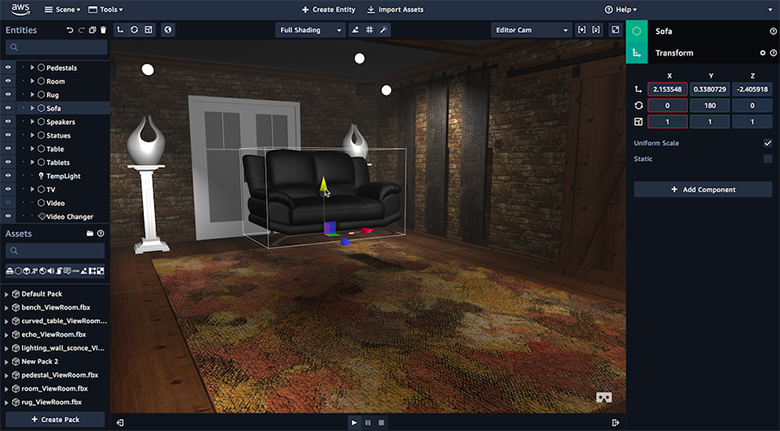
Amazon Touts Cloud-based ‘Sumerian’ Platform
Next month Amazon will release Sumerian, an ambitious new cloud-based development platform for AR & VR environments, according to PCMag, which was granted exclusive in-depth access to a preview of Sumerian, as well as its initial apps and demos.
AR & VR have yet to break out as must-have technologies, due to the chicken-and-egg conundrums of lack of content, high prices for entry and underperforming (and infamously uncool) hardware. However, the increasing use of AR apps on Apple and Android smartphones as well as more interest across the industry in next-generation VR means that some of tech’s biggest names⎯including Amazon⎯are betting on a future where AR and VR are an integral, immersive part of everyday life.
Begun at the end of 2016 with Amazon’s acquisition of failed Swedish company Goo Technologies, Sumerian was born initially of necessity but seems poised to enter the market at the same time other tech companies are flooding the market with AR/VR products. Marco Argenti, an Amazon VP who oversees Amazon’s AR/VR initiatives and projects in AWS Mobile, Serverless Computing and IoT divisions, said Amazon decided to enter the market for three reasons: the recent rise of smartphone-based AR including mainstream support by giants Apple and Google, new B2B VR applications and demand for the technology among existing Amazon Web Service customers.
“These signals were strong enough for us to actually start getting into the process of designing Sumerian. In the classic Amazon way, we started working backward from customer use cases and then eventually funding a development team to build the product,” Argenti said.
Sumerian will empower developers with a potent, unrivaled suite of development features. Rather than enter the crowded fray of AR & VR headsets and other hardware peripherals—a field which in the coming years will likely be mercilessly culled to one or two dominant champions—Amazon has created the fundamental technologies developers will use to build tomorrow’s AI and VR content upon, rather than fighting the coming platform wars.
“We made a choice. We could have gone down a path of making our own proprietary thing and pushing developers toward that,” said Argenti. “What we decided instead is to be as broad as possible in supporting what we think will be a massive market […] We’re going after the underlying foundation.”

A screenshot of Sumerian in action, demonstrating the construction of an indoor virtual theatre environment. Image from Amazon
Sumerian is impressive in its flexibility, catering to almost all current standards and tools used in the gaming, VR and AR spaces. Sumerian fully supports other development kits such as ARKit, ARCore, Windows Mixed Reality, as well as offering full support for standards in 3D modeling (supporting most popular 3D file formats as well as the Sketchfab API, with support forthcoming for TurboSquid and Google’s Poly), AR/VR web development (WebGL, WebAR, WebVR, and WebXR), and competing development engines (such as Unity, Unreal Engine, and Vuforia).
In addition to its platform agnosticism, Sumerian offers a simple, cloud-based UI that negates the need to download or install software and provides developers with a drag-and-drop interface so simple that the company claims developers can create AR/VR experiences without writing a single line of code. Sumerian also offers more experienced users full functionality for interaction with a JavaScript command line interface and external API support.

An example of Sumerian’s virtual “hosts.” Image by Amazon
Another groundbreaking feature of Sumerian is the inclusion of “hosts,” autonomous virtual avatars with which users can interact in AR & VR spaces. Inspired by games such as Second Life and The Sims and taking their names from the AI-powered androids of Westworld, Sumarian’s hosts are created using some of the same AI technologies which power Amazon’s voice assistant, Alexa, including Alexa’s text-to-voice and natural language processing engines. New technology will help the hosts interact with their virtual environment and app users in a fairly realistic and lifelike way, such as making virtual eye contact with users of Sumerian apps. Sumerian’s host AI integrates advanced sentiment analysis to “[analyze] text to extract metadata on things like mood and sentiment analysis” enabling a host in a virtual environment to “have a different facial expression or manner or speaking based on the mood of the person they’re interacting with.”
While Sumerian will include two pre-loaded hosts (named Cristine and Preston), Amazon expects companies to eventually create fully interactive hosts in Sumerian (or Maya SDK, with Sumerian support) with unique appearances, voices and personalities which can engage users of tomorrow’s AR & VR applications.
Some early applications for hosts include the virtual weather presenters demonstrated to PCMag by WeatherBug, or the host named “Addison” planned for use by the company Electronic Caregiver in kiosks and eventual home use for seniors. Electronic Caregiver expects that technology averse senior citizens might find interacting with a virtual human more accessible than typing on a computer keyboard, smartphone or tablet. The hosts could help with communicating with healthcare professionals, taking healthcare surveys and calling for assistance:
“Getting seniors to adopt technology is not so easy,” said Electronic Caregiver CTO Bryan Chasko. “As it gets better, voice technology is going to engage that market. You’re never going to get them to sit down in front of a keyboard and a mouse, but with Addison they can just have a conversation.” For elderly users living on their own, the AI could do things like remind them to take medication or automatically call 911 if there’s a fall or other medical emergency.
Even more advanced uses of hosts could be implemented with increased AI and IoT capabilities. In a Minority Report-esque turn, PCMag’s review notes that employing Sumerian apps on IoT devices could allow for, say, avatars that walk alongside you in real time on interactive billboards or talk with you in a virtual or augmented space a la Blade Runner 2049. Far from creating an advertisement-saturated consumer dystopia though, the review also describes more innovative uses for IoT-enabled Sumerian apps. For instance, a host on a cruise liner could notice that a passenger is hopelessly far away from the dinner venue on the other side of the ship, so the host might virtually interact with them and suggest pushing back the dinner reservation to a later time.
Sumerian might be one of the foundational technologies underpinning AR and VR, exciting and overlapping fields whose most brilliant and perhaps world-changing uses have likely yet to be conceived. One particularly novel idea involves using VR and/or AR to help us learn better. For instance a user could be placed in a virtual French bistro with French-speaking hosts and menus to practice the language. Sumerian’s hosts already support more than two dozen languages.
For PCMag’s full Sumerian preview, read here.







Leave A Comment